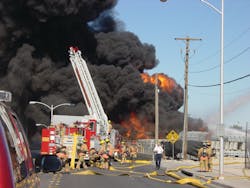Fire Service PIO: Tips for Taking Photos at Incident Scenes
Of course, you’ve heard the expression, “A picture is worth a thousand words.” For me, it means can write a media release about an incident, but a photo shows what I cannot put into words. That is why I take photos at nearly every incident to which I respond. It is easy and makes my job as the department’s public information officer (PIO) easier.
Although cell phones are being used more often than the typical camera to take pictures, I still like to use a standard camera for my PIO work. There are a variety of cameras PIOs can use. For most calls, I use a nine-MB digital camera with flash card inserted to take photos during the day. It is small enough to keep in my PIO vest pocket and it is set on the automatic mode (usually “P” on digital camera) so I can take it out and start taking photos immediately. I take photos of anything, usually starting when I walk from my response vehicle until I get to the command post. That usually consists of photos of the fire, smoke, apparatus setup, firefighters and anything else that is interesting. I hang my camera around my neck so it is immediately available to take a quick photo while I perform my other PIO duties at the incident.
As the incident starts to wind down, I take photos of other interesting things such as damage, different angles of the incident for a different perspective. I suggest that you take photos of whatever you find interesting; something you would like to look at if you were watching the news or reading a newspaper.
Here are some rules I follow when taking photos at an incident that may apply to you:
• If you are working in an official capacity for the department (PIO, fire photographer, etc.), all photos taken at the fire scene are public information items and must be kept on file and available upon request for the amount of time (retention) the law requires for your jurisdiction. Photos that are taken for fire investigation purposes are protected and do not have to be released.
• Take photos that are interesting and show what your department is doing. Many times, you are on the scene before the media. Take photos that show the action.
• Do not take photos of civilians or firefighters who are injured or if a fatality occurs; that is done by investigators and is protected.
At night, I use a professional camera so I can adjust the iris and timing for taking photos in the dark. The only way to become proficient at this is by practicing. Experiment and take photos at night every chance you get. Most cameras now have digital viewers, so you can see the photo you just took; if it is not good enough, then take another one. At night, I take many photos, but only a few are good enough to be used.
I also use video cameras from time to time, depending on the situation and if time permits. That is usually at larger incidents where I have more time. I usually leave it on the dash of my vehicle so it cannot be taken away.
Sometimes, I use the camera in my cell phone when I do not have a camera with me or I want to send an immediate photo to the media or staff at fire headquarters. Although these photos are good enough show what happened, they are not of sufficient quality for reproduction in a newspaper or posting on a website.
When the incident is over I take the flash card out and download my photos into my computer while I am drafting my media release. I make a folder for each incident and transfer my photos to that folder. I usually select two or three of my best action photos and send them to the media with my media release. Almost always, my photos are used by one of the media sources, especially if they did not have anyone to send to the incident. I am asked on a routine basis by the media whether I took any photos. I also send the photos to the entire department so everyone can see what our department accomplished at the incident.
Over the past few years, I have received requests from the public and lawyers for copies of the photos, which we provide as required by the Freedom of Information Act. The photos can also be used for PowerPoint presentations, pamphlets and posters by your department. It is very satisfying to be watching the TV news or seeing a poster somewhere in your department using a photo you took. It is just another way a PIO provides a service to the public and the department.
